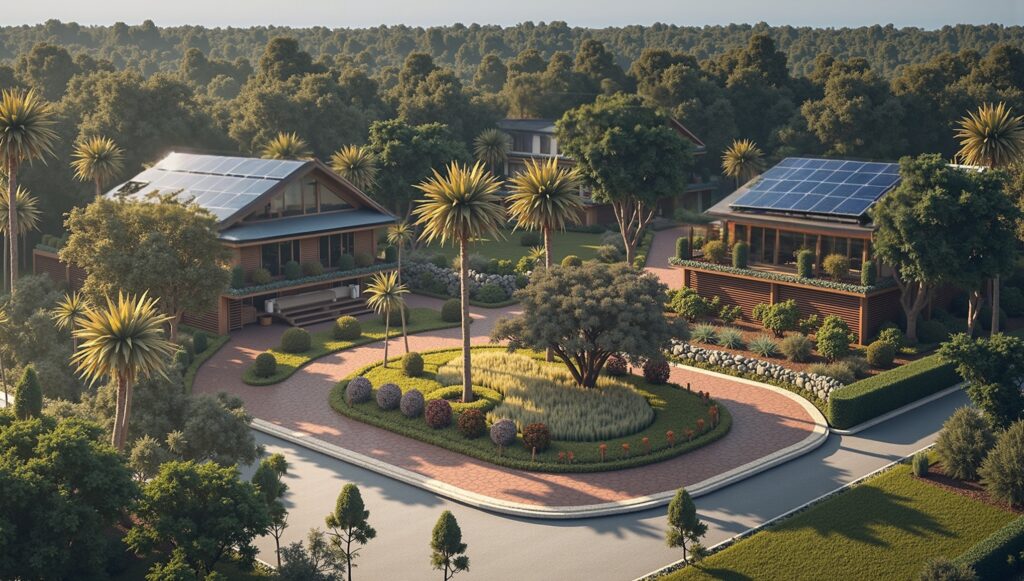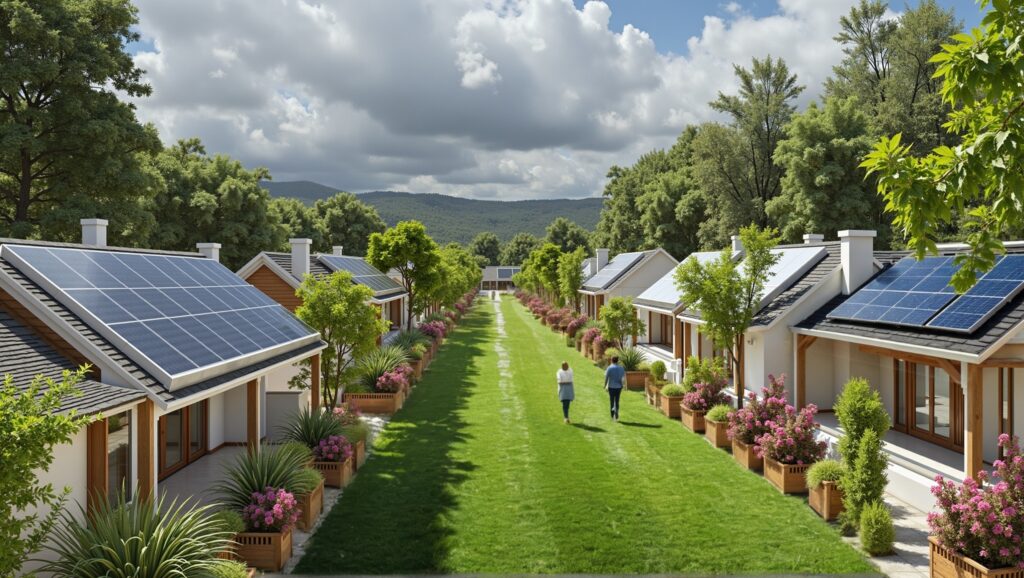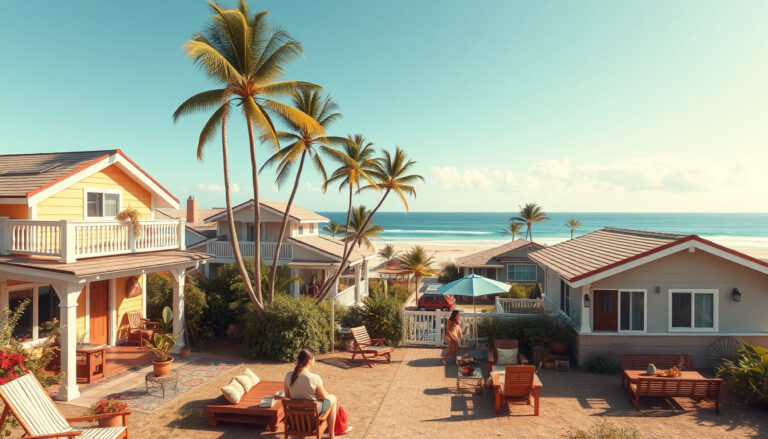In recent years, the concept of sustainable living communities has gained traction as more individuals and families seek to minimize their ecological footprint while enjoying a high quality of life.
These intentional communities focus on environmental stewardship, social responsibility, and economic resilience, fostering a holistic approach to living that benefits both residents and the planet.
In this article, we will explore the key benefits of sustainable living communities, including their positive environmental impacts, social advantages, and economic incentives.
Additionally, we will provide insight into how you can get involved in these vibrant, eco-friendly communities that are paving the way for a greener future.

Key Takeaways
- Sustainable living communities promote eco-friendly practices that benefit the environment.
- Residents of sustainable communities enjoy improved social connections and well-being.
- These communities often lower living costs through shared resources and energy efficiency.
- Sustainable living can significantly reduce an individual’s carbon footprint.
- Getting involved in these communities can foster sustainable habits and a greener lifestyle.
Introduction to Sustainable Living Communities
Costa Rica has become a beacon for eco-conscious individuals seeking to embrace a healthier lifestyle, with its thriving sustainable living communities that pepper the region.
These communities are designed with the dual purpose of promoting environmental stewardship and fostering a sense of belonging among residents.
By utilizing renewable resources, such as solar energy and rainwater collection systems, these developments not only minimize ecological footprints but also enhance the quality of life for their inhabitants.
What sets Costa Rican sustainable living communities apart is their commitment to integrating nature with modern amenities, resulting in picturesque settings that blend seamlessly with lush landscapes.
Whether you are interested in purchasing a home or simply exploring the lifestyle options available, Costa Rica’s sustainable communities offer a unique opportunity to invest in both real estate and a greener future.
Key Benefits of Sustainable Living
Sustainable living communities offer numerous benefits that attract individuals and families seeking a healthier, more environmentally-friendly lifestyle.
First and foremost, these communities are designed to reduce ecological footprints through practices such as energy efficiency, waste management, and the use of renewable resources.
By living in a sustainable community, residents often enjoy lower utility bills and a minimized impact on the planet.
Additionally, these communities foster a greater sense of belonging and connection among residents, who are typically like-minded individuals committed to sustainability.
This collaboration leads to strong social ties and shared resources, further enhancing the quality of life.
Furthermore, sustainable living promotes the consumption of local produce and supports local economies, ultimately leading to healthier diets and stronger community resilience.
With the increasing awareness of climate change and environmental degradation, choosing to live in sustainable living communities is not just a lifestyle choice—it’s an investment in a more sustainable future for generations to come.
‘The greatest threat to our planet is the belief that someone else will save it.’ – Robert Swan

Environmental Impact of Sustainable Communities
The development of sustainable living communities is becoming increasingly significant as we navigate the challenges posed by climate change and urbanization.
These communities prioritize eco-friendly practices, often incorporating green technologies that reduce carbon footprints, conserve water, and promote biodiversity.
Each sustainable living community aims to create a harmonious balance between human habitation and nature, often featuring energy-efficient homes, communal gardens, and renewable energy sources such as solar panels.
The environmental impact is profound; these communities not only lower utility costs for residents but also foster a sense of community stewardship, encouraging members to engage in eco-conscious habits.
Moreover, sustainable living communities contribute to local economies by sourcing materials and services locally, reducing transportation emissions.
As more people prioritize environmental consciousness, the role of these communities will likely continue to grow, shaping a more sustainable future for generations to come.
Social Advantages of Living Sustainably
Living sustainably is not just about reducing your carbon footprint; it also brings numerous social advantages, particularly within sustainable living communities.
These communities foster environments where residents share common values around conservation and environmental responsibility, which cultivates a strong sense of belonging and interconnectedness.
Engaging with like-minded individuals promotes collaborative efforts in community projects, such as communal gardens, local recycling initiatives, and renewable energy programs, enhancing social cohesion.
Additionally, sustainable living communities often prioritize inclusivity and shared resources, leading to decreased living costs and increased opportunities for social interaction, education, and wellness.
By participating in community efforts and fostering friendships based on mutual respect for nature, residents of sustainable living communities can enjoy healthier and more connected lifestyles.

Economic Benefits of Sustainable Living
In recent years, the concept of sustainable living communities has gained significant traction as individuals and families seek to minimize their environmental footprint while enhancing their quality of life.
These communities not only promote eco-friendly practices, such as recycling, energy efficiency, and sustainable agriculture, but they also offer substantial economic benefits.
By investing in renewable energy sources and local resources, residents of sustainable living communities can significantly reduce their utility costs and reliance on imported goods.
Furthermore, these neighborhoods often foster a sense of community and collaboration, encouraging local businesses and creating job opportunities that contribute to the local economy.
The growth of sustainable living communities is also increasingly appealing to environmentally conscious homebuyers, leading to rising property values in these areas.
As more people recognize the financial and ecological advantages of such lifestyles, the demand for sustainable living communities continues to soar, making them a smart investment for the future.
How to Get Involved in Sustainable Living Communities
In recent years, sustainable living communities have gained significant traction, attracting individuals who are environmentally conscious and eager to contribute to a greener future.
To get involved in these communities, first, research existing sustainable living models that resonate with your values—be it eco-villages, co-housing initiatives, or permaculture farms.
Joining online forums and social media groups can also provide you with a wealth of information and networking opportunities.
Attending workshops, community meetings, or related events will not only deepen your understanding but also allow you to connect with like-minded individuals.
If you’re looking to settle in a sustainable living community, consider locations that prioritize eco-friendly practices and initiatives.
Engaging in local volunteer programs can also pave your way into these communities, giving you hands-on experience while promoting sustainability.
Always remember, the foundation of sustainable living communities lies in collaboration and shared values, so finding a group that aligns with your vision is crucial.
Frequently Asked Questions
What are sustainable living communities?
Sustainable living communities are residential areas designed to promote environmentally friendly practices, reduce waste, conserve resources, and foster a sense of community among residents.
These communities often prioritize green building practices, renewable energy use, and sustainable agriculture.
What are the key benefits of living in a sustainable community?
Key benefits include reduced environmental impact through energy efficiency, access to local food sources, enhanced social interactions among residents, and potential cost savings on utilities and other living expenses.
How do sustainable living communities impact the environment?
Sustainable communities significantly reduce carbon footprints by implementing eco-friendly practices such as solar energy usage, water conservation, recycling programs, and organic gardening, which all contribute to a healthier planet.
What social advantages are provided by sustainable living communities?
Residents often experience improved social cohesion, a stronger sense of belonging, and increased opportunities for collaboration and community engagement, leading to overall enhanced quality of life.
How can I get involved in a sustainable living community?
Getting involved can start by researching local sustainable living initiatives, attending community meetings, volunteering for environmental projects, or even considering moving to an established sustainable community.





